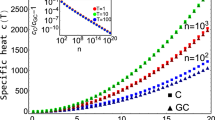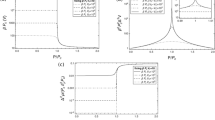Abstract
DEVIATIONS from ideality of real gases are generally attributed to the effects of the volume of the molecules and to the attractive forces between them. The volume effect has been described fairly simply and accurately, but explanations put forward as to the way in which the attractive forces act are open to criticism. One of the older common explanations1 is that the unbalanced attraction inwards on the molecules near the boundary wall results in their being slowed down before they hit the wall, thus giving a lower contribution to the pressure than they would in the absence of attractive forces. As stated, this appears to be a violation of the Principle of Equipartition of Energy. Another way of expressing what is probably the same thing, is often preferred2. In this, the deficiency in pressure is attributed to a lower concentration in the boundary layer arising out of a relatively higher potential energy in this layer, due to the attraction inwards. These explanations ignore the fact that adsorption measurements show that all known walls exert a strong attractive force on all gaseous molecules and that the concentration in the boundary layer is invariably higher than that in the body of the gas.
This is a preview of subscription content, access via your institution
Access options
Subscribe to this journal
Receive 51 print issues and online access
$199.00 per year
only $3.90 per issue
Buy this article
- Purchase on Springer Link
- Instant access to full article PDF
Prices may be subject to local taxes which are calculated during checkout
Similar content being viewed by others
References
See, for example, O. Maass “Physical Chemistry” by Taylor, vol. 1, p. 98 (1924); W. C. McC. Lewis “Kinetic Theory”, p. 72 (1923); and Washburn “Principles of Physical Chemistry”, p. 38 (1921).
Fowler, “Statistical Mechanics” p. 291 (1936).
Keesom, W. H., Phys. Z., 22, 129 and 643 (1921); 23, 225 (1922).
Core, A. F., Phil. Mag., 46, 256 (1923).
A brief treatment is given by Herzfeld and Smallwood, “Physical Chemistry” by H. S. Taylor, p. 226 (1931).
Van der Waals, Nobelpreisrede (Leipzig, 1911).
Volmer, Z. Elektrochem., 35, 555 (1929).
Author information
Authors and Affiliations
Rights and permissions
About this article
Cite this article
GOODEVE, C. The Cluster Theory of Imperfect Gases. Nature 140, 424–425 (1937). https://doi.org/10.1038/140424a0
Issue Date:
DOI: https://doi.org/10.1038/140424a0
Comments
By submitting a comment you agree to abide by our Terms and Community Guidelines. If you find something abusive or that does not comply with our terms or guidelines please flag it as inappropriate.



